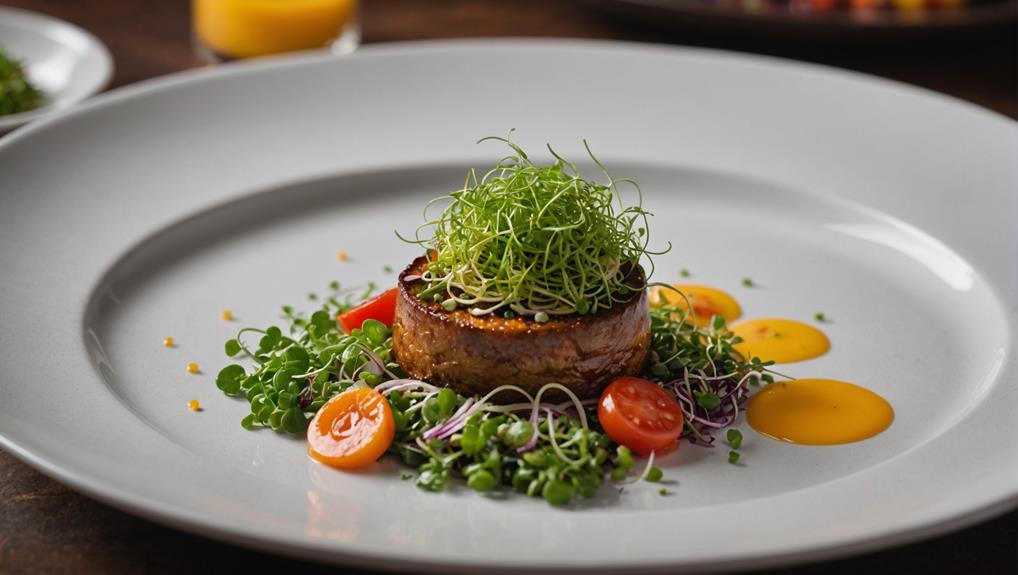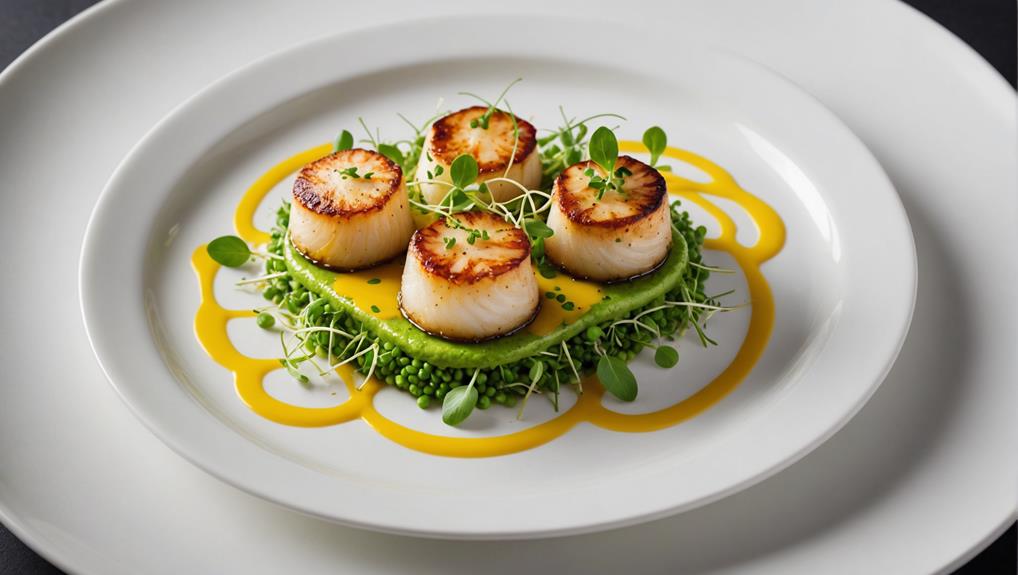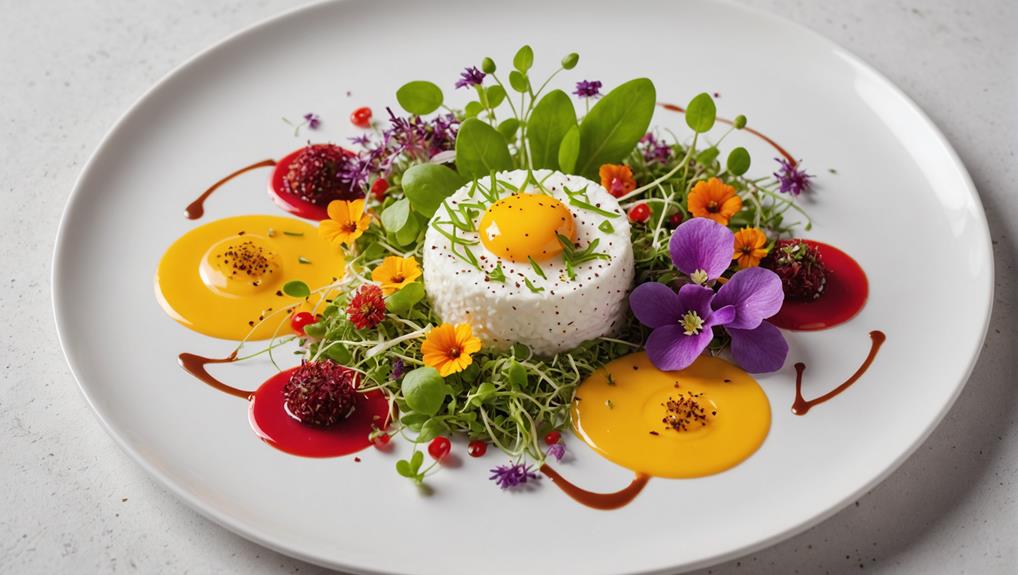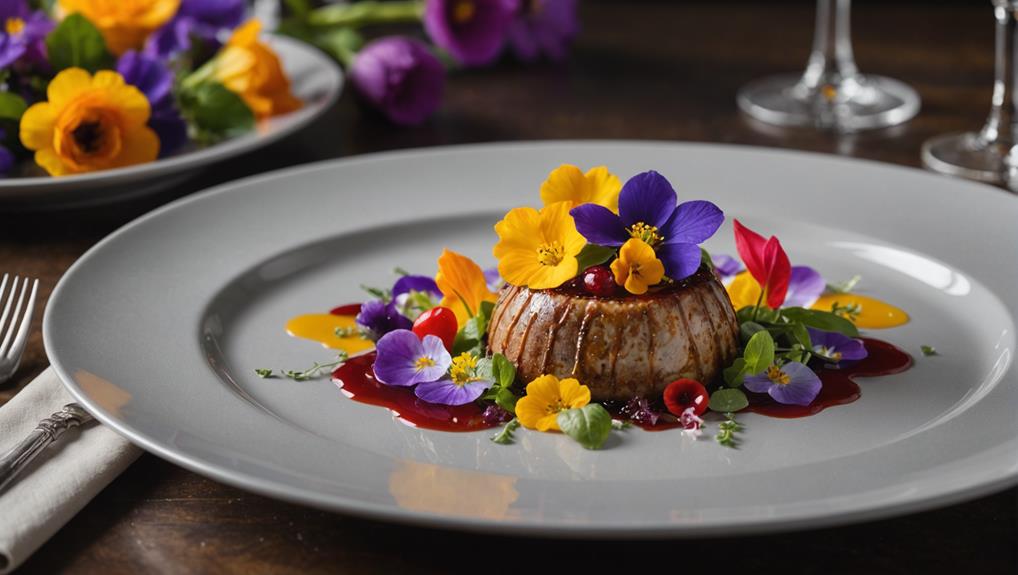Transform your dishes into visual masterpieces with three essential plating secrets. First, embrace visual storytelling by arranging components to guide the diner's eye and create a narrative on the plate. Second, balance colors and textures to engage multiple senses, combining vibrant hues with contrasting surfaces for a multi-dimensional experience. Third, employ precision in component placement, using techniques like the Rule of Thirds and Clock Method to achieve harmony and consistency. Remember to utilize negative space effectively, preventing overcrowding and highlighting each element. By mastering these secrets, you'll elevate your culinary creations from mere sustenance to edible art. Explore further to unlock the full potential of your plating skills.
The Art of Visual Storytelling
The Art of Visual Storytelling
One of the most powerful tools in a chef's arsenal is the ability to tell a story through plating. As you embark on your culinary journey, mastering the art of visual storytelling will elevate your food plating to new heights.
For instance, the presentation of a dish like a Grilled Peach and Burrata Salad can be an excellent example of how to engage diners visually. Consider each dish as a canvas, where you'll craft a narrative that engages diners before they even take their first bite.
To create visual appeal, employ the rule of thirds in your presentation of food. This technique guides the eye to key elements, creating a dynamic composition that's both balanced and intriguing.
Don't shy away from bold color contrasts; they're essential in evoking emotions and highlighting the freshness of your ingredients. As you arrange each component, think about how it contributes to the overall story and flavor combinations.
Balancing Colors and Textures
When balancing colors and textures on your plate, you'll want to explore vibrant vegetable arrangements that catch the eye and excite the palate.
Experiment with contrasting texture combinations, such as pairing silky sauces with crunchy toppings, to create a multi-dimensional eating experience.
If you're feeling bold, try working with monochromatic color schemes, which can be just as striking when executed with varying shades and textures within a single color family.
Vibrant Vegetable Arrangements
Creating vibrant vegetable arrangements is an art form that can transform a simple dish into a visual masterpiece. In the culinary world, chefs are constantly seeking innovative ways to present their creations. By incorporating a variety of colorful vegetables and using contrasting colors, you'll elevate your dish's visual appeal and stimulate your diners' appetites.
Additionally, consider drawing inspiration from refreshing dishes like a watermelon feta salad, which highlights the beauty of color and texture through the use of different ingredients.
To create stunning vegetable arrangements, consider these key techniques:
- Incorporate a rainbow of vegetables, from vibrant bell peppers to deep purple eggplants.
- Blanch vegetables to preserve their bright colors and enhance textures.
- Arrange vegetables artistically, such as fanning sliced radishes or stacking heirloom tomatoes.
- Balance soft and crunchy textures to enrich the sensory experience.
When plating, focus on showcasing the natural colors and shapes of your vegetables. Pair bright greens with fiery reds or oranges to create a striking visual impact.
Don't be afraid to experiment with unique combinations, like creamy avocado and crispy radishes, to keep diners engaged throughout the meal. By mastering these techniques, you'll create visually appealing dishes that are as pleasing to the eye as they're to the palate.
Contrasting Texture Combinations
Beyond vibrant colors, the interplay of textures adds depth and excitement to your plated creations. As a culinary innovator, you'll want to master the art of plating by incorporating contrasting textures that engage all the senses. Start by pairing crunchy elements like toasted nuts with creamy components such as pureed sauces, just as you'd balance the flaky crust of a chicken pot pie with its rich filling a classic comfort food. This combination creates a captivating sensory experience that invites diners to explore each bite.
To achieve visual interest, consider searing meats to create a crispy exterior while maintaining a tender interior. Complement this with blanched vegetables that retain their vibrant color and satisfying crunch. The Maillard reaction not only enhances flavor but also introduces a delightful textural contrast.
When arranging your artfully plated version, strategically place elements with textural diversity to guide the diner's experience. This approach encourages flavor blending through each contrasting bite, elevating your dish from ordinary to extraordinary.
Monochromatic Color Schemes
Three key principles define the art of monochromatic plating: harmony, depth, and intention. When you're crafting a dish using monochromatic color schemes, you're not just creating a meal; you're composing a visually striking masterpiece.
By utilizing varying shades and tones of a single color, you'll achieve a harmonious presentation that captivates diners without overwhelming their senses.
To elevate your monochromatic plating skills, consider these innovative techniques:
- Incorporate contrasting textures within the same color palette
- Utilize bright and muted variations to evoke different emotions
- Guide the diner's eye across the plate with intentional arrangement
- Focus on ingredient quality to enhance the overall impact
Precision in Component Placement

When it comes to precise component placement, you'll want to employ the Rule of Thirds, which involves positioning key elements off-center for visual intrigue.
You can also utilize the Clock Technique, arranging ingredients as if they were on a clock face to guide the diner's eye and promote balanced consumption.
Rule of Thirds
The Rule of Thirds is a powerful plating technique that can transform your dish from ordinary to extraordinary. By dividing your plate into three equal sections, you'll create a visually appealing arrangement that guides diners' eyes across the entire presentation.
This thoughtful plating approach enhances the overall dining experience by positioning key components off-center, creating a balanced and harmonious composition.
To master the Rule of Thirds in food plating, follow these innovative steps:
- Imagine a 3×3 grid on your plate
- Place the focal point at one of the grid's intersection points
- Distribute other elements strategically across the remaining sections
- Use negative space to prevent overcrowding and highlight each component
Clock Technique Application
Mastering the Clock Technique is essential for chefs aiming to elevate their plating game. This innovative approach to plating food transforms your dish into a visually stunning masterpiece, enhancing the overall dining experience. By organizing components like a clock face, you'll create an artful arrangement that guides diners' eyes around the plate.
To apply this technique, imagine your plate as a clock. Place your starchy components at 10 o'clock, proteins at 2 o'clock, and vegetables at 6 o'clock. This layout of ingredients ensures a balanced visual appeal while allowing each element to shine.
As a skilled chef, you'll find that this method helps achieve harmony through proportion, preventing overcrowding and creating a clear focal point with the main protein. The Clock Technique isn't just about aesthetics; it's a practical tool for consistency.
By adopting this approach, you'll find it easier to replicate successful presentations across different dishes. Remember, the goal is to create a logical and visually engaging arrangement that complements flavors and textures.
With practice, you'll perfect this technique, turning each plate into a work of culinary art.
Focal Point Positioning
At the heart of exceptional plating lies focal point positioning, a technique that elevates your dish from mere sustenance to a visual masterpiece. By strategically placing the main component off-center, you'll create a visually stunning presentation that captivates diners' attention.
The Rule of Thirds serves as your guide, ensuring balance and intrigue on the plate.
To master focal point positioning and enhance overall presentation, consider these key strategies:
- Maintain white space around the focal point to frame and highlight it.
- Elevate the focal point through stacking or leaning for added dimension.
- Use the Clock Technique to arrange supporting elements thoughtfully.
- Employ careful arrangement to guide diners' eyes across the plate.
Elevating Dishes Through Garnishes
Elevating dishes through garnishes is an essential skill for chefs looking to transform their creations from ordinary to extraordinary. When selecting garnishes, remember they should be edible and complement the dish's flavors, enhancing both visual appeal and taste. Fresh herbs, microgreens, and edible flowers are excellent choices, adding vibrant colors and textures that elevate your plate's overall presentation.
Strategic use of sauces as garnishes can create striking color contrasts and highlight key ingredients, making your dish visually captivating. Experiment with height and placement to create dynamic visual interest, guiding diners' eyes across the plate. However, timing is crucial; add garnishes just before serving to ensure freshness and maintain their aesthetic quality.
To innovate your plating technique, consider these tips:
- Layer garnishes to create depth and dimension.
- Use contrasting shapes and sizes to add visual intrigue.
- Incorporate unexpected elements, like savory granolas or flavored oils.
- Play with negative space to make garnishes stand out.
- Utilize garnishes that echo the dish's main components for cohesion.
Creating Depth and Dimension

Creating depth and dimension on a plate transforms a simple meal into a captivating culinary experience. As a chef, you'll want to employ meticulous techniques to elevate your dishes visually. By strategically placing each component, you can guide diners' eyes across the plate, creating a journey of flavors and textures.
To achieve depth and dimension in your plating, consider these innovative approaches:
- Utilize vertical stacking to create height and visual interest.
- Implement the clock technique for balanced ingredient placement.
- Employ molds to craft defined structures and layers.
- Incorporate height variation to showcase flavor complexity.
In the culinary arts, mastering these plating secrets will set you apart. Start by using stacking techniques to draw the eye upward, showcasing layers of flavors.
The clock technique organizes ingredients strategically, placing starches at 10 o'clock, proteins at 2 o'clock, and vegetables at 6 o'clock. This method ensures a balanced presentation that's visually appealing and functional.
Don't hesitate to use molds for creating precise shapes and adding height to your dishes. Remember, strategic placement is key to guiding diners through your culinary creation, encouraging them to explore and enjoy each carefully crafted element.
Mastering Negative Space
On the culinary canvas, mastering negative space is an essential skill for chefs seeking to elevate their plating. You'll find that the strategic use of empty areas on your plate can dramatically enhance visual appeal, allowing your main components to shine.
By maintaining clean plates and avoiding overcrowding, you're not only creating a more appetizing presentation but also guiding your diners' eyes to explore the dish's artistry.
To effectively utilize negative space, consider adopting the rule of thirds. This technique involves placing your main elements off-center, creating a dynamic balance that draws attention to key ingredients.
Embrace a minimalist approach by keeping your plates uncluttered, letting the quality and colors of your food take center stage. Remember, the empty spaces aren't just voids; they're powerful tools in your culinary artistry arsenal.
As you refine your plating skills, you'll discover that mastering negative space isn't about leaving things out—it's about thoughtfully framing your creations.
This approach not only enhances the visual impact of your dishes but also communicates your innovative spirit and attention to detail, elevating the entire dining experience.
Harmonizing Flavors With Presentation

Three key principles guide the harmonization of flavors with presentation: color contrast, texture variety, and strategic placement. As you craft your culinary masterpiece, remember that your plating is an extension of your art. The visual appeal of your dish can significantly enhance the perceived taste, creating a more satisfying experience for your diners.
To elevate your plating game and harmonize flavors with presentation:
- Utilize the rule of thirds to create a balanced composition
- Incorporate contrasting colors to stimulate visual interest
- Play with varying textures to engage multiple senses
- Use the clock technique to guide the tasting journey
When you're plating, consider how each element contributes to both the visual and flavor profile of your dish.
Strategically place moist ingredients like sauces to stabilize the presentation while enhancing overall taste. Experiment with crunchy garnishes paired with creamy components to create a multi-sensory experience that draws attention to your dish's flavors.
Frequently Asked Questions
What Are the 3 Styles of Plating Food?
You'll find three main plating styles: classic, modern, and natural. Each employs unique techniques, focusing on elements like color contrast, texture variety, plate choice, portion control, garnish placement, and sauce application to create visually stunning and innovative dishes.
What Are the 3 Most Important Things to Remember When Plating Food for Presentation?
When plating food, you'll want to focus on color balance, texture contrast, and portion control. Choose the right plate, strategically place garnishes, vary height, and apply sauces thoughtfully. These elements create visually striking, innovative presentations.
How to Plate Food Like a 3 Star Michelin Chef?
Did you know 90% of taste perception is visual? To plate like a 3-star Michelin chef, master garnish techniques, color contrast, and texture balance. Select the right plate, perfect portion sizing, apply sauces artfully, and tell a visual story.
What Is the Secret of a Good Chef?
You'll excel as a chef by mastering culinary creativity, flavor balance, and ingredient selection. Your secret lies in perfecting plating techniques that enhance visual appeal, while skillfully combining texture contrasts and color harmony to captivate diners' senses.
Final Thoughts
As you've explored these plating secrets, you've unlocked a world of culinary artistry that'll make your dishes sing louder than a thousand symphonies. Remember, visual storytelling, balance, and precision are your tools for creating masterpieces. By mastering colors, textures, placement, and garnishes, you'll elevate your dishes to new heights. Don't forget the power of negative space and the harmony between flavors and presentation. With practice, you'll transform everyday meals into unforgettable culinary experiences.















